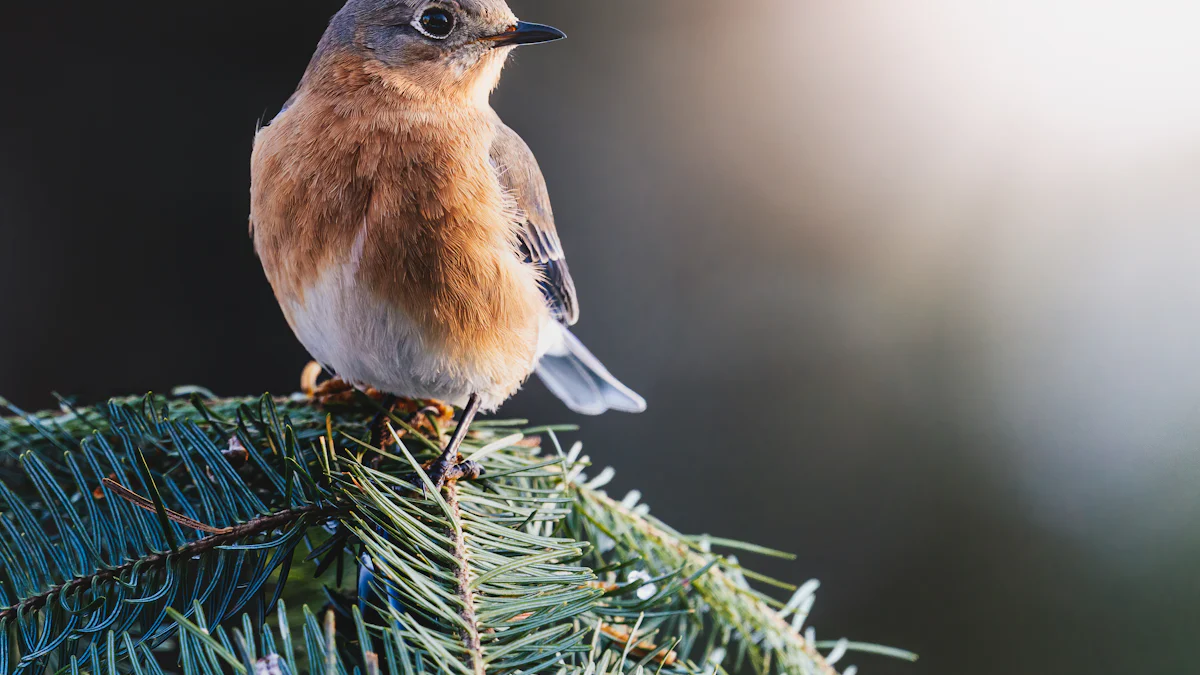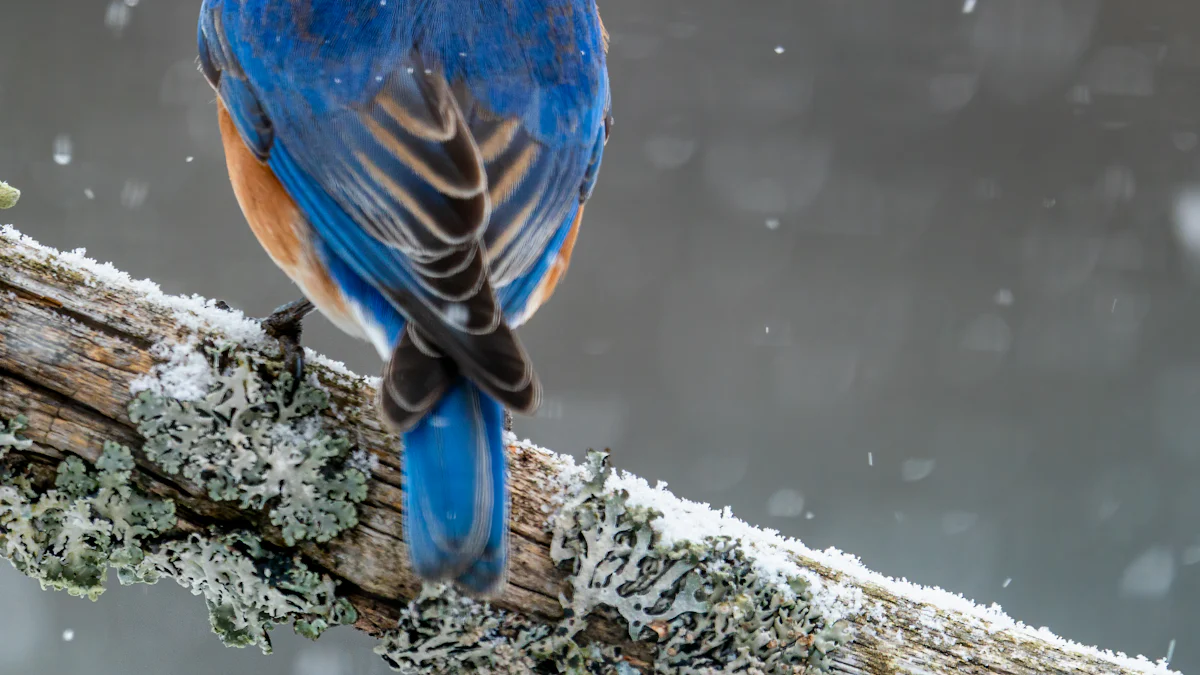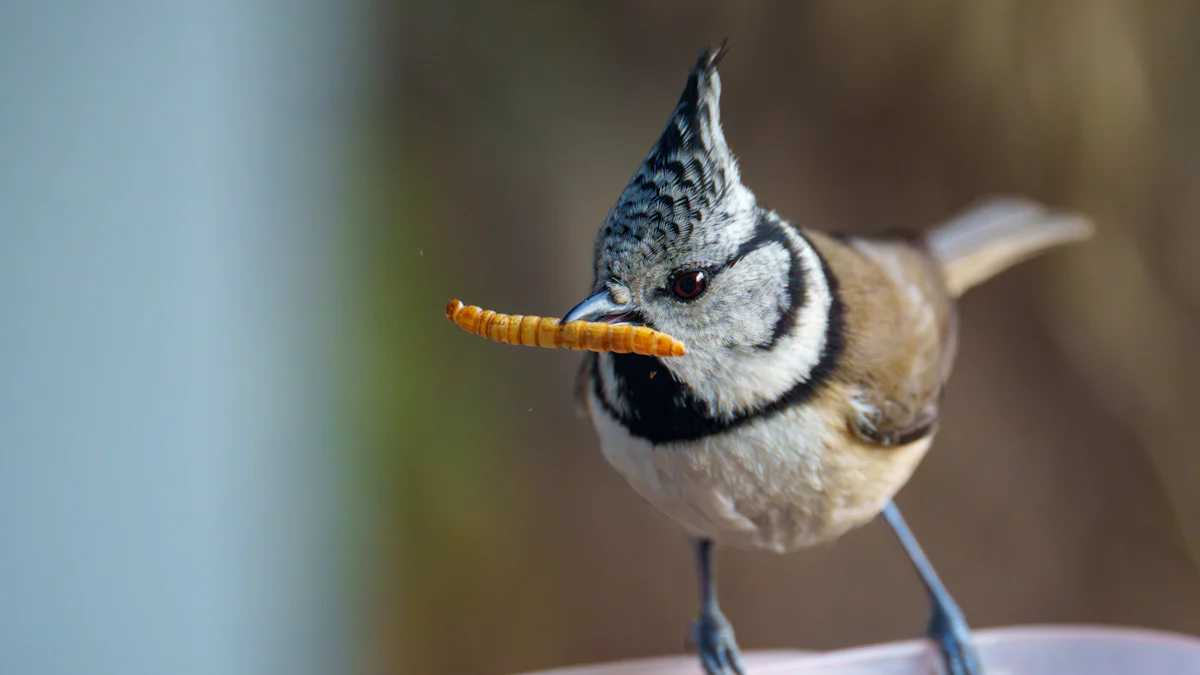
Dried mealworms for birds offer a nutritious and practical feeding option. They are packed with protein, fat, and fiber, which help birds stay healthy and energetic. You can use them to attract a variety of species, from bluebirds to robins. Unlike live mealworms, dried ones are easy to store and handle. This makes them a convenient choice for anyone who enjoys feeding birds in their backyard. By adding them to your feeding routine, you provide birds with a reliable source of energy, especially during colder months.
Key Takeaways
- Dried mealworms have lots of protein, fat, and fiber. They are a healthy food choice for birds.
- Soaking dried mealworms in warm water makes them softer. This is especially good for feeding baby birds.
- Feed dried mealworms in the morning or afternoon for energy. Birds get the most benefits during these times.
- Mix dried mealworms with seeds or suet for balance. This mix attracts many different bird types.
- Keep dried mealworms in a cool, dry place. Use an airtight container to keep them fresh and safe.
Nutritional Benefits of Dried Mealworms for Birds

Key Nutrients in Dried Mealworms
Dried mealworms for birds are a powerhouse of essential nutrients. They are rich in protein, which helps birds build strong muscles and feathers. Protein also supports their energy needs, especially during migration or nesting seasons. Along with protein, dried mealworms contain healthy fats. These fats provide birds with the energy they need to stay active and warm, particularly in colder weather.
Fiber is another important nutrient found in dried mealworms. It aids in digestion and keeps birds’ digestive systems functioning properly. Additionally, dried mealworms are a natural source of vitamins and minerals like potassium, iron, and magnesium. These nutrients contribute to overall health, helping birds maintain strong bones and a robust immune system.
By offering dried mealworms, you give birds a balanced and nutrient-dense food option. This makes them an excellent addition to your bird-feeding routine.
Comparison: Dried Mealworms vs. Live Mealworms
When deciding between dried and live mealworms, you should consider their differences. Both options provide similar nutritional benefits, but dried mealworms for birds are more convenient. They do not require refrigeration or special care, unlike live mealworms, which need to be kept alive until feeding time. This makes dried mealworms easier to store and handle.
Dried mealworms also have a longer shelf life. You can buy them in bulk and store them for months without worrying about spoilage. Live mealworms, on the other hand, can die quickly if not stored properly. While some birds may prefer the movement of live mealworms, many species readily accept dried ones once they recognize them as food.
In terms of cost, dried mealworms are often more affordable in the long run. Their convenience and ease of use make them a practical choice for bird enthusiasts. Whether you choose dried or live mealworms, both options provide excellent nutrition for birds.
Feeding Dried Mealworms to Birds

Preparing Dried Mealworms
Before feeding dried mealworms to birds, you should prepare them properly to make them more appealing. While dried mealworms are ready to use straight from the package, soaking them in warm water for 10-15 minutes can make them softer and easier for birds to eat. This step is especially helpful during nesting season when baby birds need softer food. After soaking, drain the water and place the mealworms in your feeder.
You can also mix dried mealworms with other bird foods, such as seeds or suet, to create a more balanced meal. This combination attracts a wider variety of birds and ensures they get a mix of nutrients. Always check the packaging for any specific instructions or recommendations from the manufacturer.
Best Times to Feed Dried Mealworms
Timing plays an important role in feeding birds. Early morning is the best time to offer dried mealworms. Birds are most active in the morning as they search for food to replenish their energy after the night. You can also feed them in the late afternoon, especially during colder months when they need extra energy to stay warm overnight.
Seasonal changes also affect feeding habits. During spring and summer, birds need more protein for nesting and raising chicks. In fall and winter, they rely on high-energy foods like mealworms to survive harsh weather. By adjusting your feeding schedule, you can support birds year-round.
Birds That Benefit Most from Dried Mealworms
Many bird species enjoy dried mealworms, but some benefit more than others. Bluebirds, robins, wrens, and chickadees are among the top species that love this nutritious treat. These birds rely on protein-rich foods to maintain their energy levels and health. Insect-eating birds, in particular, find dried mealworms irresistible.
During migration, dried mealworms for birds provide a quick energy boost. They also help backyard birds during nesting and molting seasons. By offering mealworms, you attract a variety of species and support their nutritional needs.
Storage and Sourcing of Dried Mealworms
Proper Storage Practices
Storing dried mealworms properly ensures they stay fresh and safe for birds. Keep them in a cool, dry place away from direct sunlight. Exposure to heat or moisture can cause them to spoil or attract pests. Use an airtight container to protect them from humidity and insects. If you buy in bulk, divide the mealworms into smaller portions and store them in separate containers. This helps you avoid opening the entire supply repeatedly, which can expose it to air and moisture.
For long-term storage, consider refrigerating or freezing dried mealworms. This method extends their shelf life and preserves their nutritional value. Always check the packaging for specific storage instructions. Following these practices ensures the mealworms remain a healthy food source for birds.
Where to Buy Dried Mealworms
You can find dried mealworms for birds at many retailers. Local pet stores and garden centers often carry them in the bird-feeding section. Online marketplaces like Amazon or specialty bird-feeding websites offer a wide variety of options. Buying online allows you to compare prices and read reviews to find the best product for your needs.
Some stores sell dried mealworms in bulk, which can save you money if you feed birds regularly. Look for trusted brands that prioritize quality and safety. Always check the product description to ensure the mealworms are free from additives or preservatives.
Identifying High-Quality Dried Mealworms
High-quality dried mealworms provide the best nutrition for birds. Look for mealworms that are whole and uniform in size. Broken or crumbled mealworms may indicate poor handling or storage. The color should be a natural golden brown, not overly dark or pale. A strong, unpleasant odor can signal spoilage or low quality.
Check the packaging for information about the drying process. Freeze-dried mealworms often retain more nutrients than heat-dried ones. Products labeled as “human-grade” or “premium” usually meet higher quality standards. By choosing high-quality mealworms, you ensure birds receive a safe and nutritious treat.
Maximizing the Benefits of Dried Mealworms
Combining Dried Mealworms with Other Foods
You can enhance the nutritional value of your bird feed by mixing dried mealworms with other foods. Birds benefit from a diverse diet, and combining mealworms with seeds, nuts, or fruits creates a balanced meal. For example, adding mealworms to a seed mix provides both protein and carbohydrates. This combination supports birds during high-energy activities like migration or nesting.
Suet is another excellent pairing. Mixing dried mealworms into suet blocks or cakes creates a high-energy treat that birds love, especially in winter. You can also sprinkle mealworms over fresh fruit slices, such as apples or oranges, to attract fruit-eating species. This method works well for birds that prefer a mix of insects and fruits.
Experiment with different combinations to see what works best for the birds in your area. Offering variety not only attracts more species but also ensures they receive a range of nutrients.
Encouraging Birds to Eat Dried Mealworms
Some birds may hesitate to try dried mealworms at first. You can encourage them by placing the mealworms in a visible and accessible location. Use a platform feeder or scatter them on the ground where birds naturally forage. Position the feeder near shrubs or trees to make birds feel safe while eating.
If birds still seem uninterested, try soaking the mealworms in warm water. This softens them and makes them resemble live insects, which many birds find irresistible. Mixing mealworms with familiar foods, like seeds or suet, can also help. Birds often recognize the familiar food first and then try the mealworms.
Patience is key. Birds may take time to adjust to new food. Once they recognize dried mealworms as a reliable food source, they will return regularly.
Dried mealworms for birds offer a nutritious and practical feeding option. They provide essential nutrients like protein and fat, which help birds stay healthy and energetic. You can store and handle them easily, making them a convenient choice for bird enthusiasts. By following proper feeding and storage practices, you can attract a variety of bird species to your yard. Start incorporating dried mealworms into your bird-feeding routine today to support the health and well-being of your feathered visitors.
FAQ
What are the main benefits of feeding dried mealworms to birds?
Dried mealworms provide birds with protein, fat, and essential nutrients. These nutrients support muscle growth, energy, and overall health. They are also easy to store and handle, making them a convenient option for bird enthusiasts. Birds benefit most during nesting, migration, and colder months.
Can all bird species eat dried mealworms?
Not all birds eat dried mealworms. Insect-eating species like bluebirds, robins, and wrens enjoy them the most. Seed-eating birds may not show interest. You can attract a variety of species by mixing mealworms with other foods like seeds or suet.
How do I store dried mealworms to keep them fresh?
Store dried mealworms in a cool, dry place. Use an airtight container to protect them from moisture and pests. For long-term storage, refrigerate or freeze them. Always check the packaging for specific storage instructions to ensure freshness.
Should I soak dried mealworms before feeding them to birds?
Soaking dried mealworms in warm water for 10-15 minutes softens them. This makes them easier for birds to eat, especially during nesting season when baby birds need softer food. While soaking is optional, it can make mealworms more appealing to birds.
Are dried mealworms safe for birds?
Yes, dried mealworms are safe for birds when sourced from reputable brands. Look for high-quality products free from additives or preservatives. Always store them properly to prevent spoilage. By following these steps, you ensure a safe and nutritious treat for your feathered visitors.


